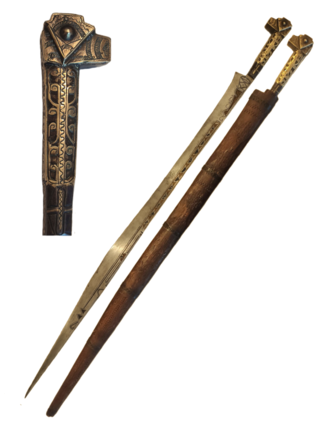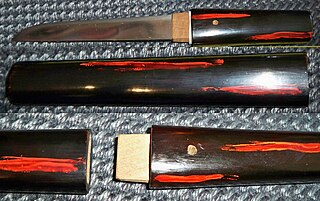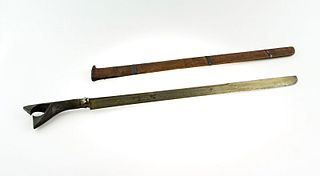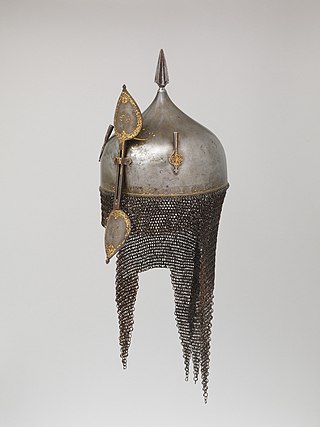Related Research Articles

Chain mail is the name of a type of armour consisting of small metal rings linked together in a pattern to form a mesh. It was in common military use between the 3rd century BC and the 16th century AD in Europe, while still being used in Asia, Africa, and the Middle East. A coat of this armour is often called a hauberk or sometimes a byrnie.

A shamshir is a type of Persian/Iranian sword with a radical curve. The name is derived from the Persian word shamshīr, which means "sword". The curved "scimitar" sword family includes the shamshir, kilij, talwar, pulwar, and nimcha.
A man catcher, also known as catchpole, is a type of pole weapon.
The Kabutowari, also known as hachiwari, was a type of knife-shaped weapon, resembling a jitte in many respects. This weapon was carried as a side-arm by the samurai class of feudal Japan.
A seme, simi or ol alem is a type of dagger or short sword used by the Maasai and Kikuyu peoples of Kenya in East Africa.

A shotel is a curved sword originating in Eritrea and northern Ethiopia. The curve on the blade varies from the Persian shamshir, adopting an almost semicircular shape. The blade is flat and double-edged with a diamond cross-section. The blade is about 40 inches (1,000 mm) in total length and the hilt is a simple wooden or rhinoceros horn piece with no guard similar to the jile or jambiya. The shotel was carried in a close fitting leather scabbard which was often decorated in precious metals and worn on the right side.

The flyssa is a traditional edged weapon of Algeria produced and used during the 19th century and earlier. It originates from the Kabyle Iflissen Lebhar tribal confederacy.

The bichuwa or bichawa is a dagger, originating from the Indian subcontinent, with a loop hilt and a narrow undulating sharp blade. It is named for its resemblance to the sting of a scorpion, for which the Hindi name is bichuwa. The weapon was based on the maduvu, or horn dagger created in South India, and many bichuwa have blades which retain the shape of buffalo horns. Early examples of the bichuwa come from the medieval southern Karnataka empire of Vijayanagara. Being relatively easy to make, the bichuwa has persisted into the 20th century as a decorative dagger.

A kaiken is a 20–25 cm (7.9–9.8 in) long, single or double-edged Japanese knife usually without ornamental fittings housed in a plain but lacquered mount.

Tatami (畳具足), or tatami gusoku and gusoku, was a type of lightweight portable folding Japanese armour worn during the feudal era of Japan by the samurai class and their foot soldiers (ashigaru). The Tatami dō or the tatami katabira were the main components of a full suit of tatami armour.
George Cameron Stone was a well-known American arms collector and author as well as an American mining engineer and metallurgist. He authored a glossary of the antique weapons of the world that remains one of the most comprehensive works ever written on the subject.

Djerid is a type of throwing spear ~1 m in length, usually with a wooden haft and small steel head, but sometimes it's entirely made of steel and used for hunting and warfare. The weapon is of Arab origin and were used in Northern Africa, Western Asia, Southern Asia, and Eastern Europe. Occasionally, several of these were carried in a quiver, either on horseback or on foot.
Moplah sword is a sword used by the Muslim population in the Malabar Coast in southwestern India. The Moplah sword has been used since the 17th Century, both as a weapon and a tool.

Kusari gusoku (鎖具足) is the Japanese term for mail armour. Kusari is a type of armour used by the samurai class and their retainers in feudal Japan. When the word kusari is used in conjunction with an armoured item it usually means that the kusari makes up the majority of the armour defence.

Sikin Panjang is a sword originated from northern Sumatra, Indonesia.

Palitai is the traditional knife of the Mentawai people, originating from the Mentawai Islands off West Sumatra, Indonesia.

The turban helmet is a historical variety of combat helmet with a bulbous shape and fluting that imitates the folds of a turban. Turban helmets originated in Ottoman Turkey, primarily used by warriors and some external attics.

Kulah Khuds were used in ancient western Asia for battle and as decorative head pieces.

A toradar is a South Asian matchlock primarily found in the Mughal Empire, dating from the 16th century. It was a preferred firearm in India well until the mid-19th century because of its simple and cheap design.

Katapu or Kalapu is a traditional war cap or helmet used by the Dayaks of Borneo. The katapu is only worn during war.
References
- 1 2 3 Person, Lawrence (Mar–Apr 1985). "Capsule Reviews". Space Gamer . Steve Jackson Games (73): 40.